Auditing your Google Analytics property can help you identify what is working well or not with your GA4 setup. It also lets you determine the health, integrity, and quality of the data you are collecting in your analytics property and which areas require improvement.
The launch of the FREE and UNLIMITED Google Analytics (GA4) audit tool that I developed at DumbData led me to write this article.

As we progress in this blog post, I’ll discuss how you can use the tool to perform the GA4 audit data checks covered in this article without spending much time.
While a simple Google search can give you numerous insightful articles or resources detailing the essential steps for auditing your GA4 setup and various tools facilitating this process, I aim to avoid redundancy by focusing on potential oversights during a GA4 audit. It’s important to note that highlighting these areas doesn’t necessarily imply neglect on your part; rather, consider this article a source of inspiration for additional aspects to consider when doing your Google Analytics audit.
In addition to discussing these often-overlooked elements, I will demonstrate how you can use the DumbData Google Analytics (GA4) audit tool to perform the referenced health checks on your analytics data.
The audit data checks that you’re likely to ignore, which we’ll cover, include:
- Session vs Users (which is higher)
- The Item data stability & availability in E-commerce hits
- Advance UTM tagging audit (errors, utm_id, poor strategy, etc.)
- Take a closer look at the GA4 “form_submit” & “form_start” enhanced measurement
- Limit monitoring (event name length, GA4 BQ export, audiences, conversion and page_location character length)
- Checks for suspicious bot traffic
- Currency stability and availability in your e-commerce hits
- Quality of transaction data
- Broken cross-domain tracking
- Broken Purchase attribution
- Check for 404s (impact, user reaction and trend)
- Privacy analysis (a deeper look)
- DataLayer availability, stability and quality
- Validating If the GA4 purchase events get recorded as transactions
- Not registering event parameters as Custom Dimensions and Metrics
- Proactiveness with data collection
- Using a first-party domain for Server-Side Tagging
- Integrating documentation into measurement practices
- GA4 integrations check for data quality & privacy compliance
Having outlined these nineteen (19) critical areas that you can easily ignore, I will examine the specifics of each check in the following sections and explain how the DumbData GA4 Audit tool can facilitate these assessments of the data collected in your Google Analytics property.
Session vs Users (which is higher)
This discrepancy often goes unnoticed because the prevailing assumption is that session counts will surpass user counts, especially in newly created analytics properties.
There are rare cases where both metrics are equal and instances (although uncommon) where users are higher than sessions. However, it is critical to check for this in your audit.
Using the DumbData GA4 audit tool, you can easily identify whether the number of users exceeds the number of sessions within your analytics property.

If you encounter such a scenario, it indicates a potential flaw in your implementation and that your data needs extra checking. The tool has some features to help initiate an investigative process directly within its interface.
The tool also provides a report trend feature, enabling the identification of specific date periods or streams associated with this anomaly.

Let us now proceed to the next item on the list.
The Item data stability & availability in E-commerce hits
This data check is helpful for websites with an online storefront utilising e-commerce tracking within their Google Analytics property.
Most GA4 audits with coverage on e-commerce tracking typically focus on the data collection and presence of e-commerce data in your analytics reports without a thorough examination to ascertain whether there are missing item parameters in your e-commerce hit recorded in Google Analytics, where the hit happened, and purchase event data with information on the item data that was recorded.
A more detailed analysis of the data may reveal implementation issues that are not large-scale but require some investigation to identify and fix any data quality problems discovered.
Utilising the DumbData Google Analytics (GA4) audit tool, you can swiftly pinpoint which item data points are absent in your GA4 e-commerce tracking events and identify where and when these discrepancies occur, as illustrated in the provided image.

The tool also enables you to review which item data were collected and assess their consistency across various e-commerce events in GA4, such as at the point of purchase, as shown in the image below.

Through the “Item Data Quality” section of the GA4 audit tool, you can efficiently identify the availability and stability of the item name and other item-specific data points (including item variant, item category, item list name, item list ID, order coupon, etc.) across e-commerce actions like “add_to_cart,” “view_item,” “begin_checkout,” and “purchase.” This tool’s functionality helps determine data integrity when using these item-scoped dimensions for performance analysis.
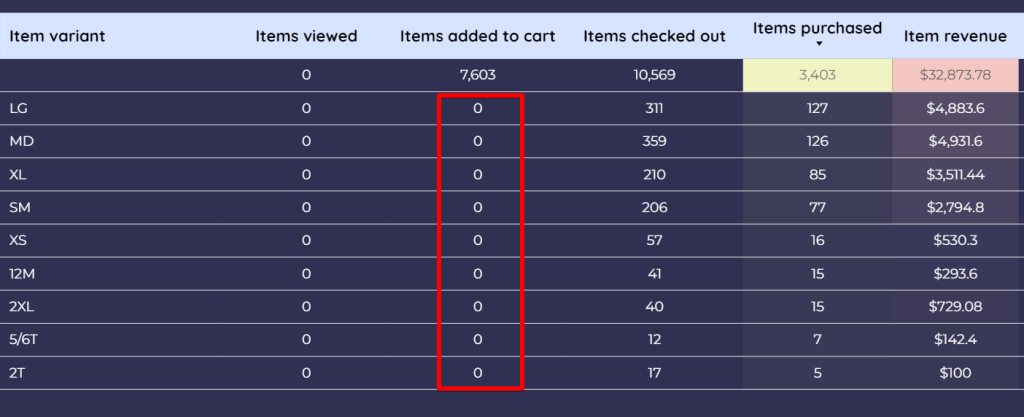
Advance UTM tagging audit (errors, utm_id, poor strategy, etc.)
Most GA4 audits primarily verify the use of UTM parameters for labelling website traffic data collected within the analytics property, yet they often overlook additional critical aspects, such as:
- Ensure that an insight-led and efficient UTM strategy is adopted, tailored to the business and the analytics property.
- Consistency in UTM parameter case formatting.
- The presence of configuration errors in UTM parameters.
- The wrong application of UTMs.
- Not UTM Tagging Your Paid Ads Traffic
Below, I elaborate on the UTM-related evaluations listed above and illustrate how the DumbData Google Analytics audit tool can assist with some, but not all, of these checks.
If you prefer not to use the GA4 audit tool for these data quality checks, you can alternatively use the FREE UTM Audit tool to identify attribution-related issues.
Adopting an Insight-Led & Efficient UTM Strategy:
This involves assessing whether UTM tags attached to your marketing landing page URLs use an appropriate structure that communicates insights and values.
This particular check involves many things, but I won’t list them all. These include the used UTM parameters, their values, naming conventions, etc.
For example, the GA4 audit tool features over 20 predefined checks for common UTM tagging strategy mistakes, enabling you to effortlessly identify and rectify such errors.
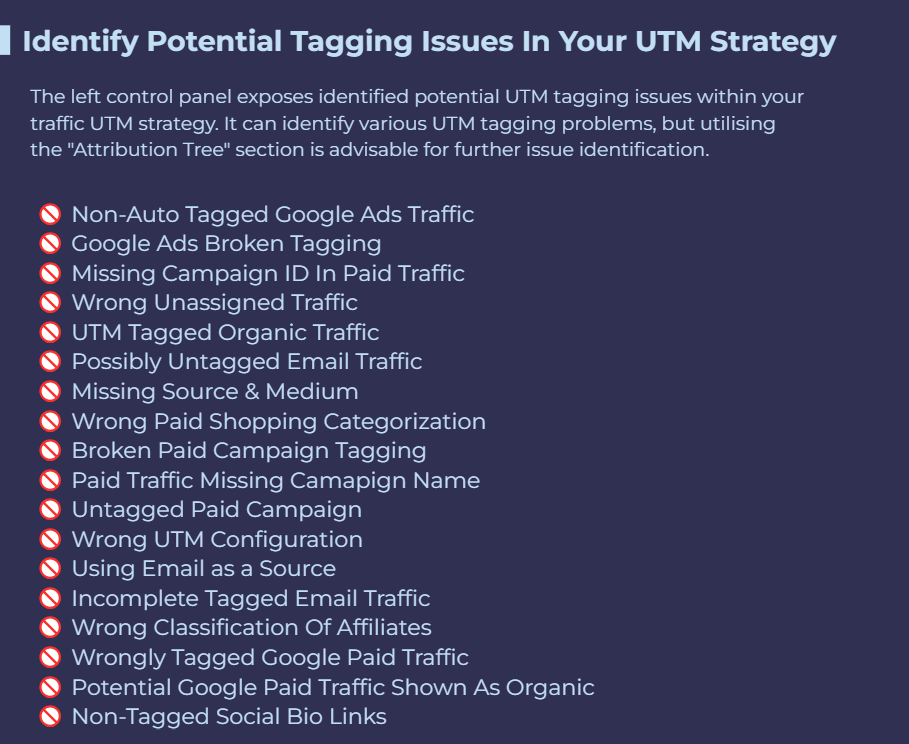
These errors can be neglecting to use “Campaign ID” for paid media campaign traffic, using “Email” as a source rather than a medium, or failing to tag paid campaigns.
UTM Case Formatting Review:
This part of the UTM audit is straightforward in what should be done, and it entails examining your UTM parameters value for case inconsistencies to determine whether your organisation utilises a lowercase format or if varied casing results in dimension value splits of what gets displayed as source, medium, and campaign values.

Error-Free UTM Configuration:
This aspect of the checks involves looking for configuration errors, such as omitting the use of the question mark sign “?” when adding UTMs to your URLs.

Another configuration check is to identify cases where the ampersand symbol “&” was replaced with the plus sign “+” to differentiate between UTM parameters.

Running this kind of audit is easy and faster, and the FREE DumbData audit tool simplifies identifying these issues using the “UTMs related” section in the audit tool. You can also use the FREE GA4-Friendly UTM Builder worksheet to create and manage UTMs easily.
No wrong Application of UTMs on the Website:
This part of UTM-related checks is meant to investigate the potential use of UTMs on internal links, a practice that isn’t ideal and can cause attribution problems.
While various methods exist for conducting these evaluations, I will not cover them in this Google Analytics-related guide, so I’ll proceed to the next item on the list.
Not UTM Tagging Your Paid Ads Traffic:
This issue arises when a paid ads campaign directs traffic to your website, but the destination page URL doesn’t have UTM parameters appended to the URL.
Without these parameters, you’ll miss out on critical insights regarding the ad campaign, including campaign ID and other vital information necessary for informed decision-making during marketing channel performance evaluations.
Often, teams focus solely on Meta (formerly Facebook) ads. However, the DumbData Google Analytics (GA4) audit tool allows you to quickly identify if any paid ad traffic is not UTM-tagged. This check encompasses campaign traffic from nine different ad platforms:
- Meta Ads
- TikTok Ads
- Snapchat Ads
- Microsoft Ads
- Taboola Ads
- Outbrain Ads
- LinkedIn Ads
- Yahoo Ads
- X (Twitter) Ads

The GA4 audit interface makes this process straightforward and quick, taking between 1 and 3 minutes to identify these mistakes. If you prefer not to conduct a full-scale audit, the FREE UTM Audit Tool developed by DumbData can also help identify these types of issues.
Take a closer look at the GA4 “form_submit” & “form_start” enhanced measurement
In your Google Analytics audit checklist, you may include provisions to check whether enhanced measurement features are activated. For example, you could have enabled “form_start” and “form_submit,” assuming these only track form interactions and submission actions.
However, it will make more sense to help your clients or stakeholders understand the advantages of turning off these GA4-enhanced measurement events. Instead, tracking these actions manually or using a similar alternative, recommended, or custom GA4 event name might be more appropriate.
Within the DumbData GA4 audit tool, you can quickly identify pages where these form-related GA4 events occur. If, upon inspection, you find no form available on such a page, it suggests that interactions with other website elements (for example, a search form or false form submission actions) are triggering these events.
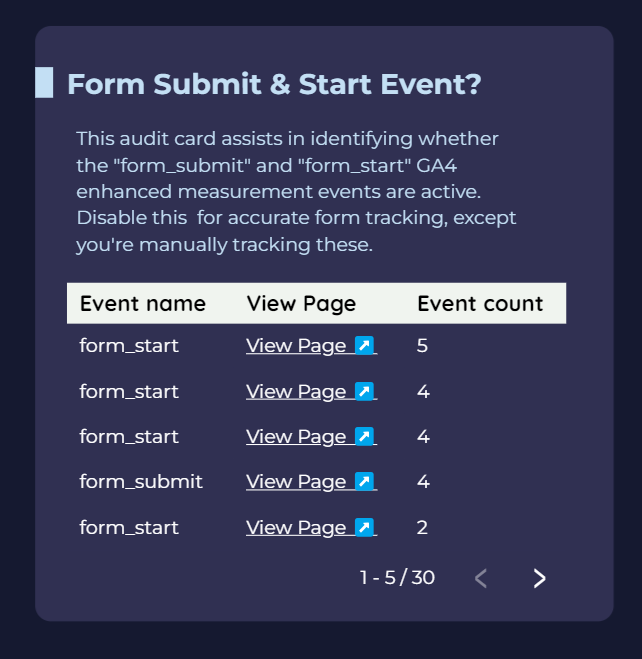
Doing a basic debug on these pages can help you determine what triggers the enabled form-related enhanced measurement GA4 events.
Limit monitoring (event length, GA4 BQ export, audiences, conversion and page_location character length)
This is probably the most commonly overlooked element of a Google Analytics audit checklist. To give credit, I drew inspiration for three of these limit monitoring concepts from the “IKAUE GA4 Audit Tool,” which inspired the building of the “DumbData GA4 Audit Tool.”
Limit monitoring data checks are essential for several reasons. For instance, if you’ve integrated GA4 with BigQuery, it’s vital to know whether you are approaching, have reached, or have exceeded the limit for the number of allowable Google Analytics events that can be exported to BigQuery daily.

On the plus side, the GA4 audit tool makes monitoring the GA4 and BigQuery event export limit easy. If you haven’t linked your Google Analytics property with BigQuery, you can use the GA4 and BigQuery worksheet we’ve developed at DumbData.
Similar checks can be conducted for conversions and audiences created within your analytics property. The GA4 audit tool enables you to assess, in percentage terms, how much of your allocated number you’ve made.
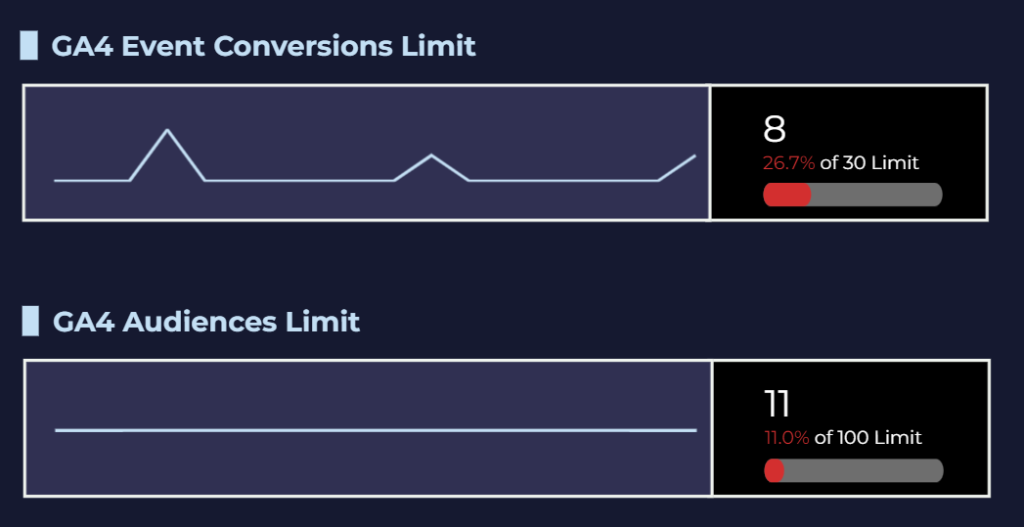
It’s important to note that the selected date range influences the data displayed in the GA4 Audit. Therefore, choosing a date range that encompasses even seasonal periods is crucial for an accurate assessment.
Unique to the audit tool developed by DumbData, you can swiftly determine if the length of your event names meets or exceeds the 40-character limit.

Additionally, the tool helps verify whether you are within the acceptable range for the character limit of the “page_location” parameter value in Google Analytics. The audit tool’s “Data Collection Check” feature makes this check possible, ensuring you remain compliant with Google Analytics’ data collection policies.

Checks for suspicious bot traffic
Identifying bot/spam traffic within the Google Analytics (GA4) interface can be challenging and often leads to incomplete information on these spammy data. Such efforts to do this within the GA4 UI typically only scratch the surface, overlooking various forms of spam, bot, or suspicious traffic to your GA4 property.
The audit tool detects suspicious traffic, potentially originating from bots or spam. It allows for a deeper investigation into these visits to ascertain their nature, and the tool’s colour coding will help categorise the type of traffic each website visit represents.

Leveraging the table chart’s filter functionality, users can swiftly isolate traffic types by their specific attributes, including location, hostname affected, operating system, device type, and the actions undertaken by the bot during the visit. This comprehensive approach facilitates a more detailed understanding of the extent and nature of bot traffic’s impact on your Google Analytics property data.
Currency stability and availability in your e-commerce hits
When conducting audits on an analytics property, you might check and test for the data collection on e-commerce actions on your online store, and from these tests, it’s easy to assume that currency information is included as a parameter with all GA4 e-commerce events, based on just a few hits.
However, when auditing a Google Analytics property, your check should extend beyond mere availability and check for the “stability” of the currency parameter, ensuring that the currency is consistently included with all e-commerce events sent to your analytics property.
If you use the analytics audit tool referenced in this article, you don’t only get to audit for stability; you also get the flexibility to identify on which pages some events fail to include the currency event parameter, which you can export to your format of preference for any further investigation.

There is also a feature that allows you to filter by the GA4 e-commerce events that are relevant that you want to access the stability of the currency parameter and what value it received.
Quality of transaction data
Verifying that transactions are tracked within your analytics property is a crucial step, yet the quality of this data truly matters. The integrity of transaction data significantly influences your analysis, which in turn plays a critical role in the data-informed decision-making process.
Key aspects to evaluate in terms of data quality include the presence and consistency of purchase-related event parameters, such as:
- Transaction ID
- Currency
- Tax
- Shipping
Additionally, examining the availability, quality, and consistency of item data captured at the point of the GA4 purchase event is vital.
The DumbData analytics audit tool supports checking the data quality of your transaction data within your or your Google Analytics property.
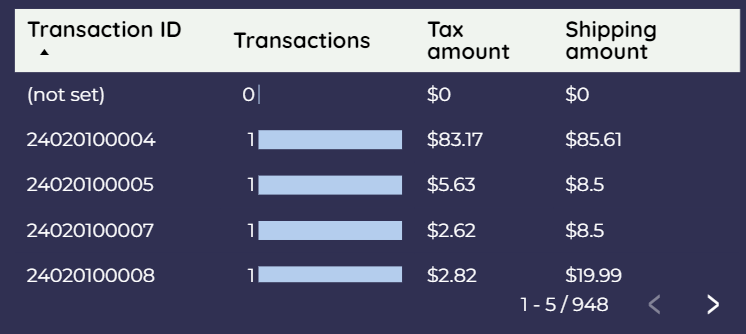
In my audit projects, I go beyond the above and perform extra checks on the quality of transaction data recorded in Google Analytics, but I won’t discuss them here.
Broken cross-domain tracking
This process also includes verifying whether clicks on URLs that lead to website domains that share the same Google Analytics tracking code erroneously trigger an outbound link click GA4 event. If so, this suggests that your cross-domain tracking configuration is broken or was never configured.
Also, the GA4 audit tool enables you to identify instances where clicks on your business website domains (with the same GA4 tracking code) trigger an outbound link click GA4 event. If such data can be found in the audit tool report, it indicates that your cross-domain tracking needs to be reviewed.

Broken Purchase attribution
It shouldn’t stop at verifying that transactions are tracked in Google Analytics. During an audit, it’s crucial to investigate any anomalies or instances of transactions being attributed as “(not set),” which could indicate potential underlying issues with your configuration or setup. However, ensure you are not looking at purchase data from the last 48 hours.
Using an image of the DumbData GA4 Audit tool, you can quickly see trends in transaction attribution within your analytics. This insight is essential for understanding how transactions get credited in your analytics property.

Additionally, the tool includes a “transaction finder” section that offers detailed insights into individual transactions. This feature allows you to review specifics such as the date and time of purchase, transaction ID, revenue, and more, further enhancing your understanding of transaction hit.

Check for 404s (impact, user reaction and trend)
In many GA4 audits, the focus might solely be on identifying 404 errors that happened without a deeper look into the nuances, such as whether a marketing campaign is directing traffic to a nonexistent landing page or analysing user behaviour on these 404 pages.
Conducting this level of detailed analysis directly within the GA4 interface can take time and effort. However, the GA4 audit tool streamlines this task, enabling you to pinpoint 404 errors quickly and provides an export option to your preferred format.

With the DumbData UTM Audit tool, you can quickly identify landing pages that result in 404 errors, which may disrupt the user experience. Additionally, the tool allows you to review the associated UTM information to determine whether the traffic originated from a paid campaign.

For a more thorough analysis of 404 errors based on your Google Analytics data, you can use the DumbData 404 error discovery Looker Studio dashboard templates, available in version 1 and version 2. These templates will help you answer more questions related to the 404s you’ve identified.
Privacy analysis (a deeper look)
I’ve observed that privacy assessments during GA4 audits often focus narrowly on checking to determine if there is a collection of Personally Identifiable Information (PII) within Google Analytics, with “email address” as the only recognised type of PII.
However, the scope of privacy considerations extends far beyond basic PII checks, and the types of PII involved should not be limited to email addresses. This is why the DumbData audit tool’s PII checks feature is more comprehensive, identifying various PII forms that might otherwise be overlooked.
This analytics audit tool offers the added advantage of providing detailed insights about the detected PII.
When conducting privacy evaluations in GA4, it’s essential to broaden the checklist to ensure adherence to the privacy guidelines relevant to your business entity. These assessments should include examining various data points, integrations, and Google Analytics configurations that potentially violate privacy regulations and infringe on user rights.
DataLayer availability, stability and quality
In this section of the GA4 audit data checks, I will provide an overview without going into exhaustive detail. Initially, it’s essential to clarify that the concept of a dataLayer isn’t limited to just e-commerce tracking in Google Analytics.
When conducting an audit of e-commerce dataLayer, several vital aspects require examination:
- Availability: This involves checking to determine if the dataLayers are present.
- Stability: Evaluate its stability by checking for issues such as duplication or inconsistent execution.
- Quality: Helps determine the quality of the dataLayer, including its structure and format, and ensures it adheres to Google’s guidelines for e-commerce tracking.
Multiple methodologies exist for these evaluations, though only a limited selection is feasible through the GA4 audit tool.
For those who prefer a checklist that serves as guidance, the DumbData FREE e-commerce dataLayer audit worksheet offers a practical resource for conducting “Availability and Quality” assessments specifically for e-commerce dataLayer audits.
Validating If The GA4 Purchase Events Get Recorded as Transactions
Tracking the GA4 “purchase” event in your analytics property doesn’t automatically mean you are tracking transactions. In Google Analytics, not all purchase events are considered transactions.
This might be new to you, but the FREE GA4 audit tool can quickly detect this issue. You can easily compare the event count for your “purchase” event with the number of transactions.

You can also identify when the purchase event didn’t get counted as a conversion, helping you determine date information associated with purchase events that were not considered transactions.

You can also see a trend analysis where you can spot the occurrence of this issue.

Additionally, you can see where this issue is occurring to investigate whether it is a deliberate action by your client or organisation or an implementation error.

Please note that Google Analytics processes transactions differently. The GA4 events that contribute to the transactions metric in Google Analytics include purchase, in_app_purchase, app_store_subscription_renew, ecommerce_purchase (deprecated), app_store_subscription_convert, and refund.
This is why the DumbData GA4 audit tool allows you to easily determine which events count toward your transaction metric and verify whether all purchase events are categorised as “e-commerce purchases.”

Not Registering Event Parameters as Custom Dimensions and Metrics
This is a common oversight in GA4 event tracking implementation.
When implementing a Google Analytics event that uses an event parameter not predefined as a dimension or metric, you must register the parameter as a custom dimension or metric in your analytics property UI.
If you don’t do this, you won’t be able to build reports using that event parameter as a dimension or metric. However, there are cases where you might intentionally avoid registering the event parameter as a custom dimension or metric due to the well-known GA4 “cardinality” issue.
To identify this issue, you may not be able to use the FREE GA4 Audit tool. However, by using a combination of Google Tag Manager or BigQuery and your analytics property admin section, you can determine if your GA4 property has such issues. Always confirm if the omission is deliberate or not.
Proactiveness With Data Collection
Proactiveness in data collection is another critical aspect often overlooked in a Google Analytics audit. Evaluating this can help you gauge how proactive a business or client is in collecting data on website visits and event data in their GA4 property.
One example of proactiveness to consider is the use of “Custom Insights” in Google Analytics. This feature allows you to set up an alert system to monitor significant changes on your website, whether positive or negative.
GA4 “Custom Insights” enables you to proactively track fluctuations in conversions, website traffic, business revenue, and other data anomalies within your analytics property.

Unfortunately, the DumbData GA4 audit tool cannot assist with this check. Instead, you’ll need to manually verify whether “Custom Insights” is set up in your analytics property UI.
When conducting your audit assessment, don’t just check for the activation and use of “Custom Insights”; you should also evaluate how strategically this GA4 feature is being used.
A detailed post on the DumbData blog covers this feature, sharing strategies for using “Custom Insights” proactively. You can find the article here to learn more.
Proactiveness also extends beyond this. Consider setting up an alert system for your server-side tagging implementation to monitor its health, billing, and performance. Additionally, if your budget allows and you’re operating a medium or large website, consider adding third-party tools to your stack to monitor data quality, such as data layers.
Using a First-Party Domain for Server-Side Tagging
When reviewing a server-side implementation setup, it’s crucial to consider whether data is being collected in a first-party context. This is one of many things you should check for when you’re actually meant to review or audit an sGTM implementation.
Since server-side tagging is being adopted for GA4 implementations, checking if a custom domain is used in a first-party context is essential for leveraging its privacy, measurement, and security benefits.
There is a (low) possibility that a business implementing server-side tagging does not collect data in a first-party context, which Is why it’s essential to check. Instead, they use a domain provided by the cloud provider (e.g., Cloud Run, AWS, App Engine) or a third-party vendor (e.g., Stape) instead of a custom domain as the endpoint.
For example, in the screenshot below, a UK-based e-commerce business’s live website uses a third-party domain from their SGTM vendor rather than a custom domain. (It might have been changed)

Doing this prevents you from fully leveraging the privacy, measurement, and security benefits that come with server-side tagging. While data still flows from the user’s browser to the server container and then to your analytics property, it operates in a third-party context.
This issue isn’t something the DumbData Google Analytics Audit tool can detect. You’ll need to use browser network requests or an Analytics Debugger Chrome extension to identify it.
Integrating Documentation into Measurement Practices
Some businesses may neglect this step, but having a measurement plan and documenting your analytics implementation is invaluable. It promotes collaboration and organisational efficiency.
The GA4 audit tool won’t reveal whether documentation exists, so you’ll need to communicate with your client or stakeholders during the implementation phase to determine if they have documentation for their analytics business use case, measurement plan, and data collection.
Reviewing these documents helps you assess whether GA4 is being utilised effectively to achieve business goals, ensuring alignment across event data collection, privacy, reporting, activation, and more.
If you’re unsure where to begin, visit the DumbData worksheets resource collection page to explore the various documents we’ve made publicly available.
GA4 Integrations Check For Data Quality & Privacy Compliance
Integrations are a powerful way to enhance a product’s capability, especially in analytics. They can help you track user interactions, enrich user or event data, improve attribution, or even use GA4 to enhance third-party tools.
Google Analytics offers seamless integration with various tools within the Google ecosystem, typically without issues. However, when it comes to third-party integrations, it’s crucial to evaluate the following:
Data Quality Impact: Here, you check to see if the integration with Google Analytics doesn’t compromise the quality of data collected in your analytics property. For instance, consider scenarios where a different client ID gets assigned to the GA4 event data emitted by a third-party tool integration with GA4 or when event data uses a GTAG event while your GA4 client in server-side Google Tag Manager is configured with “server-managed cookies.” There are many such situations to be mindful of.
Privacy Compliance: Assess whether the integration could potentially violate user privacy or if any violations have been identified.
This aspect is often overlooked, but addressing it can help uncover gaps in data quality and user privacy.
While the audit tool we’ve developed can’t assess these specific issues, I have written a comprehensive guide that details everything you need to watch out for when integrating Google Analytics (GA4) with non-Google products.
Closing Remarks
To begin with, If you would like to explore the Google Analytics (GA4) audit tool mentioned throughout this article, it is accessible via DumbData’s tool collection page, which is linked here. Secondly, it’s crucial to recognise that the scope of what should be covered in the Google Analytics audit project should not be limited to the insights shared in this article.
This blog post highlights some easily overlooked aspects and explains how the DumbData audit tool can facilitate these essential checks.
I am eager to hear about your experiences with the GA4 audit tool. I welcome your feedback, thoughts on the tool, and any requirements or assistance you may need with Google Analytics audits or setup. Feel free to connect with me on LinkedIn or reach out through the DumbData contact email on the Contact Us page.







